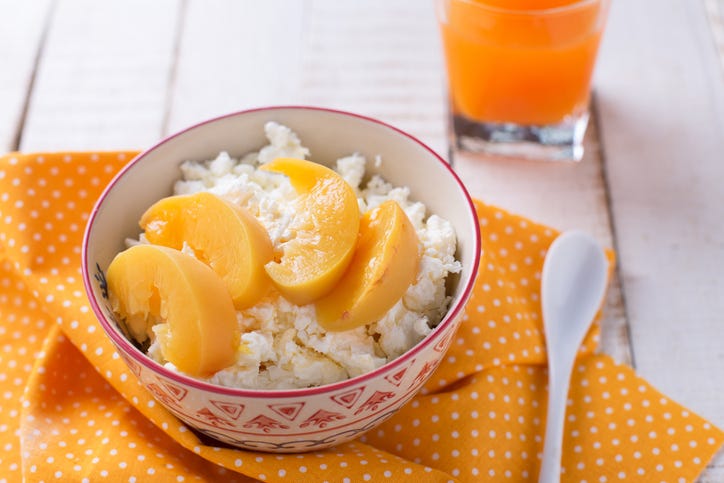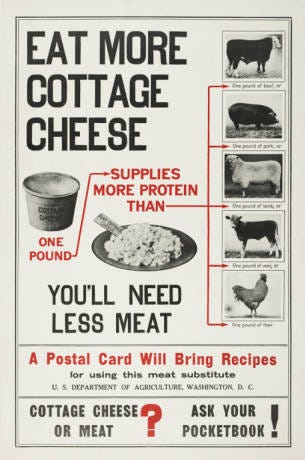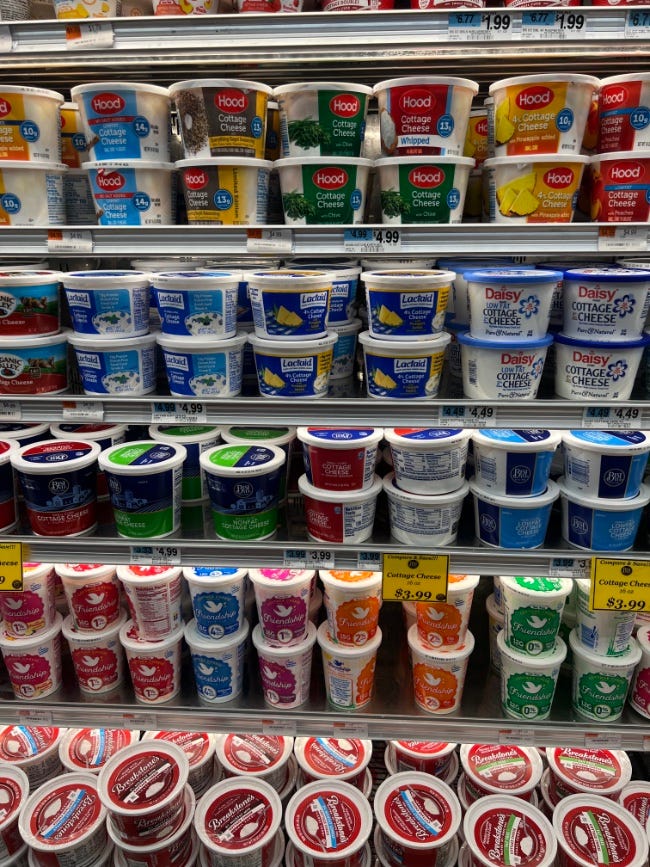The History and the Future of Cottage Cheese
Or, the things we do to "hit our macros"
One of the terrible things that diet culture encourages us to do is to eat foods that aren't delicious or that we don't like. Oh sure, folks will insist that they enjoy their fat-free peanut butter powder or that you'd never know their chocolate chip cookies are made with just three ingredients! (Canned chickpeas, maple syrup, and yogurt or something.) You don't have to openly call them out on their bullshit. But you can sure think it.
But listen. I get it. While I don't eat terrible things to lose weight, I have been known to eat terrible things because I'm trying to "hit my macros" — that is, eat just an inordinate amount of protein because I think it’ll make me stronger and faster and more resilient. Most recently, this obsession with protein led to some Kodiak brand instant oatmeal, which I purchased at a Walmart on our road trip eastward. Kodiak seems to be a very popular brand with the "influencers" — or rather, the company sponsors lots of people who smile tell you "oh wow, these protein waffles are so good!" But as far as the instant oatmeal goes, kids, it's not. (And it doesn't even contain that much protein! There's more in a small, 5 ounce yogurt!)
Another terrible thing I ate: recently, I put cottage cheese in my smoothies.

It's one of those foods that — again, this is diet culture talking — I feel like I'm supposed to eat. I typically buy Skyr — which I prefer to other yogurts and which I find edible outside of my blended smoothie concoctions. But recently, I dunno, I felt like grabbing a different plastic container of plain white dairy product. (Ricotta is an even a better choice, and if you have leftovers from making lasagna or whatever, by all means put it in a smoothie because YOLO.)
“It's a cold, convenient food that you just scoop from the container with a spoon and put in your mouth,” says Wikipedia. Yuck. No.
Part of the problem, I reckon, is that cottage cheese always makes me think of my mom and of the diets she and millions of other women pursued in the 1970s. Cottage cheese and fresh fruit — this wasn't a "lite" breakfast, but rather it was their whole goddamn lunch. (It was, as the image above reminds us, a very photogenic one though.)
Cottage cheese tastes a bit sour. Cottage cheese tastes like body shame and deprivation.
The history of cottage cheese is much much older than these weird 1970s memories — cheese-making is an ancient art, after all. The phrase "cottage cheese" was used, beginning in the mid-nineteenth century, to describe simple, homemade cheese. It's "curds and whey," really — it's made by adding an acid to pasteurized milk which causes the milk solids to separate from the whey. The remaining curds are cooked and pressed and rinsed, and salt is added. Cottage cheese doesn't need to be aged or ripened.

Consumption of cottage cheese was promoted by the US government during World War I — as we saw with corn — in order to save meat for the military. Posters boasted the protein content in cottage cheese, which remained incredibly popular even after the war — popular through the 1970s, right up until yogurt came along as the better "healthier" dairy snack for the diet-conscious. Thanks hippies!
When we arrived in New York, I noticed that the neighborhood grocery store had a lot of cottage cheese options. I don't just mean three or four brands of cottage cheese in two or three different size containers with the obligatory full-fat and low-fat options. I mean a lot of cottage cheese options: different flavors — different fruits mixed in; "everything bagel" seasoning; chives; and so on. I snapped a picture and sent it to Kin: "Is cottage cheese a thing now?"

The next day, there was a story in The New York Times: "Cottage Cheese Makes a Comeback." Apparently there is quite a bit of cottage cheese-related content on TikTok (which, being 50 and generally refusing to join any new social media sites, I don't know about unless someone shares it to Instagram or — hahahaha — The New York Times). And much of it, from what I gather, is the three-ingredient-chocolate-chip-cookie variety of bullshit.
(Sidenote: I am fascinated by the construction of these trends in the media. No sooner had The NYT crowned the cottage cheese comeback than another publication shouted "Next!": "Step Aside Cottage Cheese—There's a Trendy Protein Taking Over and It Has 75% Less Sodium." The "trendy protein" in question: tofu.)
Some of this resurgence of cottage cheese is tied up in another trend: a growing emphasis on protein consumption. I'll have more to say next week about the history of protein powder in particular, but the prioritization of protein in our diets is deeply intertwined with diet culture and fitness culture and wellness culture. (And maybe a fear of the future of food and climate change? I don't know.)
And some of it too, I think, is industry-driven. It isn't simply that young'uns on TikTok are discovering cottage cheese and “innovating” out of thin air. The dairy industry is deeply invested in our continued consumption of milk. And Americans are drinking less of it — indeed, milk consumption hit an all-time low in the US in 2021. Interestingly, per capita dairy consumption hit a record high that same year — an increase driven by the consumption of cheese and yogurt. So what's better than cottage cheese, that weird combination of the two?
(Almost anything, really. But you do you.)





